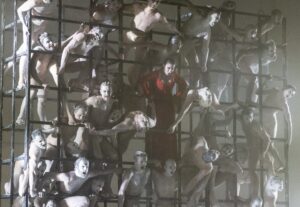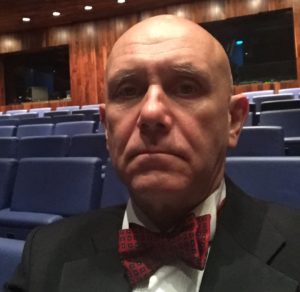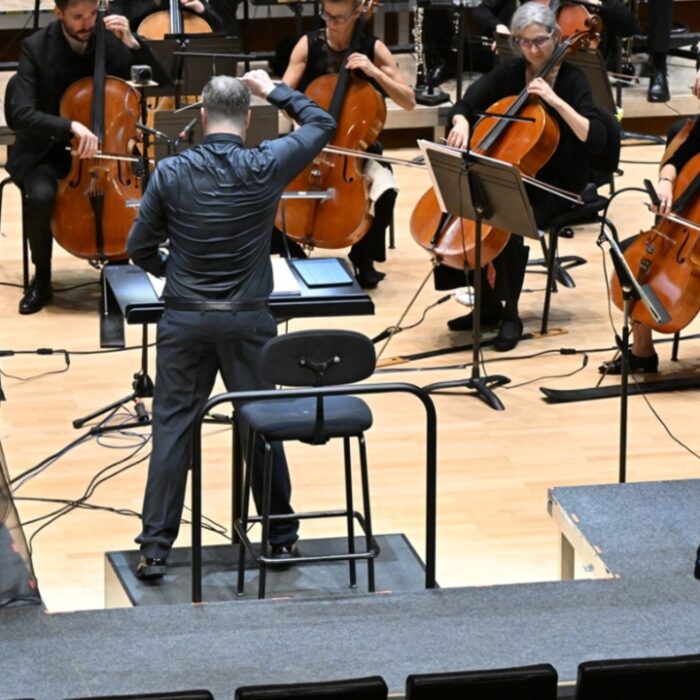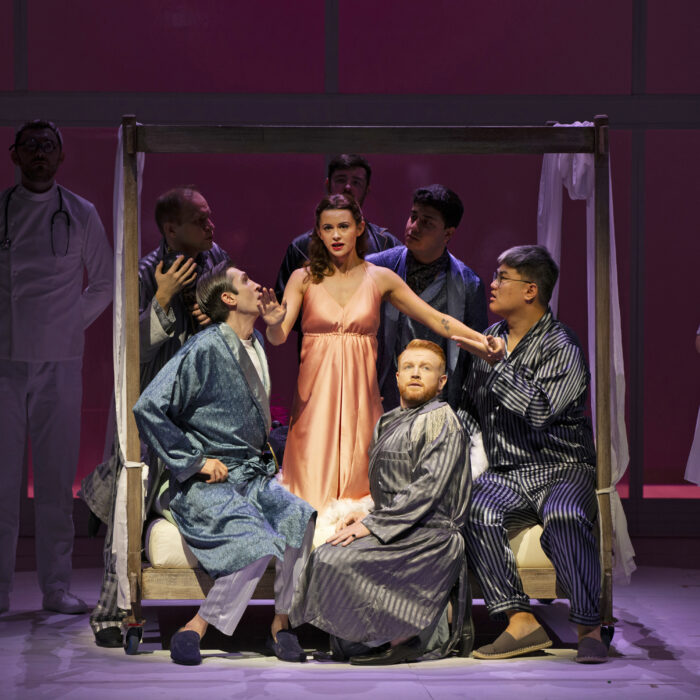
George Enescu International Festival 2025 Review: Oedipe
Enescu’s Masterpiece Receives Uninspiring Staging
By Alan Neilson(Photo: Andrei Ginda)
Sophocles’ play, “Oedipus Rex,” relates the well-known tale of a man destined to live out his life according to a prophecy from the Delphic oracle, in which he will kill his father and marry his mother. Nothing can be done to prevent the outcome. His parents’ attempts to circumvent the prophecy by having the child abandoned on a remote hillside are thwarted, and the events play out as predicted, and Oedipus, horrified by his actions, blinds himself. In a later play, “Oedipus at Colonus,” Sophocles relates Oedipus’ search for peace as he wanders the land, led by his daughter Antigone, which he eventually finds in Athens, where he dies.
It is a myth with a very clear and simple narrative, even if the underlying ideas and themes, relating to fate, free will, individual responsibility and the dark unconscious sexual impulses between mother and son, have attracted the attention of many great thinkers. It is also a myth with plenty of action; apart from patricide and incest, Oedipus also defeats the Sphinx, thereby saving Thebes, for which he gains the hand of the queen, Jocasta, his mother, and becomes its king. On the surface, it appears to be a story ready to be turned into an opera. Strangely, however, there have not been many composers who have actually chosen to do so.
One who did was the Romanian composer, George Enescu, who, with his librettist, Edmond Fleg, staged their four-act opera, “Oedipe,” at the Paris Opera in 1936. Written in French, the libretto relates Sophocles’ telling of the myth from “Oedipus Rex” as well as his wanderings with his daughter, Antigone, from “Oedipus at Colonus.” It was praised for its dramatic scope and its complex musical score and has even been described as a turning point in opera and hailed as the composer’s masterpiece. Yet, following a revival the following year, it had to wait another eight years for a performance; since which time, outside of Romania, it has received only sporadic presentations, even though it is still regarded as a work of high standing.
An Unconvincing Staging Highlights the Work’s Weaknesses
The Bucharest National Opera’s production, staged as part of the George Enescu International Festival, shone a light on why the opera is both highly praised and yet neglected at the same time.
The stage director, Stefano Poda, who also was responsible for the stage and costume designs, opted for a highly stylized, symbolic presentation. The stage, costumes and scenery were colored white, with only minimal variations in tone. The costumes, although classically inspired, were not meant to be authentic but were used to create an impression of a futuristic antiquity. The white-colored walls were divided into rectangles, each with a large eye in the centre. Although the scenery did occasionally alter, they rarely amounted to fundamental changes. The appearance of the Sphinx in Act two was the first and only notable change to the dominating aesthetic: a black cage, was placed in the centre of the stage, inside which climbed the Sphinx, dressed in a long, red robe, surrounded by its victims. In the final act, the stage is opened out to give Oedipus the space he needs to live out his final days in peace. The few props that were employed were used as symbols, such as the large dagger that descended onto the stage with the word DESTINY written along the blade.
The characters’ movements were often deliberately slow, precise and stylized. There was nothing natural about the way they presented themselves. Even the fight between Laïos and Oedipus was choreographed so that it appeared artificial. The chorus had plenty to do, but like the main characters, their stylized movements detracted rather than added to the dramatic flow; one notable exception was an imaginatively designed dance routine that stood out for the energy it was able to bring to the drama.
Ultimately, Poda’s decision to opt for a symbolic interpretation underpinned by a rigid aesthetic consistency acted against the dramatic aspects of the piece. A regular criticism of “Oedipe” is that it is more akin to an oratorio, and this production only served to confirm that opinion; it was all too one-paced. The fact that very little was made explicit often meant that their dramatic significance was blunted. Moreover, the lack of color made for a bland, insipid staging that sapped the interest of the audience.
A further point of irritation, one that related to comprehension, was the difficulty in identifying minor characters. Given the number of roles and the large chorus, in which all their costumes were colored white with a very similar design, it became almost impossible to identify a character making a short interjection on the crowded stage.
It was, in effect, an intellectual reading that did nothing to counter the longueurs of the libretto; if anything, it promoted its weaknesses and put the pressure on the music to supply the emotional and dramatic content.
Tiberiu Soare Oversees a Strong Musical Performance
The conductor, Tiberiu Soare, rose to the challenge with a strong performance from the Bucharest National Opera Orchestra, in which he successfully exploited the textural depth and density of the score to capture the menace, atmospheric gloom and sense of foreboding that hung over the stage. His expert handling of the pace created an unwavering forward momentum that plodded its way towards the inevitable outcomes, highlighting the central role of fate. Unfortunately, his efforts could not help but draw attention to the static nature of the libretto, as Enescu’s long-drawn-out climaxes were left hanging without the necessary support from the stage; their suspended resolutions, on occasions, felt unnecessarily long, even to the point of tedium.
The fourteen soloists all made strong contributions, although it was baritone Ionut Pascu in the title role who stood out. His emotionally intense interpretation managed to create some much-needed energy and dramatic tension, which, at times, almost fell at odds with Poda’s carefully stylized approach. Vocally, Oedipus is a role containing a number of lengthy, dramatically significant monologues, that he interpreted skillfully to bring out the depth of his character’s emotionally troubled existence, in which he successfully captured the magnitude of his anguish, anxiety, confusion and self-loathing through his colouring of the vocal line and expert employment of dynamic and emotional accents. His final aria, “Adieu, douce Antigone: il faut partir,” was beautifully rendered to bring out his love for Antigone and his own sense of calm as his final journey through life comes to an end.
Among the other soloists, mezzo-soprano Ruxandra Danose produced an expressively powerful portrayal of Oedipe’s mother and wife, Jocasta, in which she managed to captured the sheer horror of her situation.
Mezzo-soprano Ramona Zaharia caught the attention with her mysterious interpretation of the Sphinx, in which she displayed a pleasing vocal flexibility and ability to coat her voice with the rich, beautifully coloured tones of her palette.
Vazgen Gazaryan’s resonant, expressive and authoritative bass provided him with the necessary gravitas to essay the role of the High Priest with the necessary force.
Contralto Andreea Iftimescu expertly captured the anxieties and apprehensions of Oedipus’ adoptive mother, Merope, in an expressively sung reading that showed off her firm, secure and beautifully colored voice to good effect.
Bass Alexei Botnarciuc possesses a resonant, lyrically arresting voice, which he used successfully to create a strong, compelling portrait of the blind seer, Tiresias.
The other soloists included bass Leonard Bernad as Phorbas; tenor Andrei Lazar, who produced a clearly sung portrait of The Shepherd; bass Damian Vlad as The Watchman; bass Adrian Sampetrean, who produced a compelling interpretation of the complex character of Creon; contralto Zoica Sohterus as the Theban Woman; soprano Kaarin Cecilia Phelps, who created a sympathetic reading of Antigone; bass Daniel Filipescu, who produced a lyrically pleasing interpretation as Thesee; and tenor Paul Curievici as Laïos.
The Bucharest National Opera Choir played a wide variety of roles, including the Theban women, warriors, shepherds, virgins, Theban men, and the elders of Athens. The singing was neatly managed to meet the demands of their changing circumstances, moving between outpourings of grief, fear, joy and praise, and was sensitively balanced to align with the orchestra and soloists.
They were accompanied by a fine performance from the Bucharest National Opera Children’s Chorus.
Despite some excellent singing performances and a dramatically strong reading from the orchestra, this was not a theatrically convincing presentation. Undoubtedly, this is partially a problem with the work itself; there are far too many scenes that lack the necessary tension and forward momentum to hold the attention of the audience, and rightly this has led many critics to declare that the work is more akin to an oratorio than an opera, which is no doubt the reason for its inability to gain a permanent place in the repertoire outside Romania. However, it was Poda’s directorial choices that were the main problem as they exacerbated the work’s underlying weaknesses without successfully exploiting its strengths.



